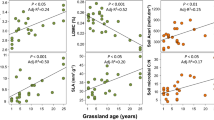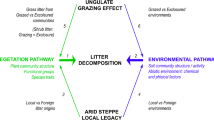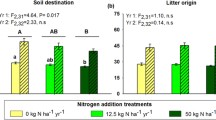Abstract
Plant species can both directly and indirectly affect soil processes in various ways, including through functional traits related to the quantity and chemistry of biomass produced. Understanding how functional traits affect soil processes may be particularly important in restorations that specifically select a target plant community. In this study, I examined how species differing in litter traits alter decomposition, both directly via chemistry and indirectly via influences on soil microclimate. Decomposition dynamics of two old-field grasses were compared with the native prairie grass, Andropogon gerardii, in two Michigan old-fields. Decomposition rates were strongly, negatively related to tissue chemistry, but showed little effect of microclimate differences. Soil bacterial community composition differed between species at one site, while extracellular enzyme activities differed between species at the other site. These findings suggest plant species may be altering microbial community function. Overall, litter chemistry was the dominant factor determining decomposition rates, suggesting that restoring native prairie grasses with recalcitrant litter into grass-dominated old-fields could slow litter decomposition and ultimately lead to changes in soil carbon and nitrogen cycling. Eventually, this could lead to soils that more closely resemble the more organic-rich soils of native prairies and ultimately increase prairie plant community restoration success.




Similar content being viewed by others
References
Aerts R (2006) The freezer defrosting: global warming and litter decomposition rates in cold biomes. J Ecol 94:713–724
Averett JM, Klips RA, Nave LE, Frey SD, Curtis PS (2004) Effects of soil carbon amendment on nitrogen availability and plant growth in an experimental tallgrass prairie restoration. Restor Ecol 12:568–574
Ayres E, Dromph KM, Bardgett RD (2006) Do plant species encourage soil biota that specialise in the rapid decomposition of their litter? Soil Biol Biochem 38:183–186
Baer SG, Kitchen DJ, Blair JM, Rice CW (2002) Changes in ecosystem structure and function along a chronosequence of restored grasslands. Ecol Appl 12:1688–1701
Blackwood CB, Waldrop MP, Zak DR, Sinsabaugh RL (2007) Molecular analysis of fungal communities and laccase genes in decomposing litter reveals differences among forest types but no impact of nitrogen deposition. Environ Microbiol 9:1306–1316
Burbank DH, Pregitzer KS, Gross KL (1992) Vegetation of the W.K. Kellogg biological station, Kalamazoo County, Michigan. Michigan State University Agricultural Experiment Station, East Lansing, p 72
Burke DJ, Martin KJ, Rygiewicz PT, Topa MA (2005) Ectomycorrhizal fungi identification in single and pooled root samples: terminal restriction fragment length polymorphism (TRFLP) and morphotyping compared. Soil Biol Biochem 37:1683–1694
Burke DJ, Kretzer AM, Rygiewicz PT, Topa MA (2006) Soil bacterial diversity in a loblolly pine plantation: influence of ectomycorrhizas and fertilization. FEMS Microbiol Ecol 57:409–419
Callaham MA, Rhoades CC, Heneghan L (2008) A striking profile: soil ecological knowledge in restoration management and science. Restor Ecol 16:604–607
Camill P, McKone MJ, Sturges ST, Severud WJ, Ellis E, Limmer J, Martin CB, Navratil RT, Purdie AJ, Sandel BS, Talukder S, Trout A (2004) Community- and ecosystem-level changes in a species-rich tallgrass prairie restoration. Ecol Appl 14:1680–1694
Castanho CD, de Oliveira AA (2008) Relative effect of litter quality, forest type and their interaction on leaf decomposition in south-east Brazilian forests. J Trop Ecol 24:149–156
Craine JM, Tilman D, Wedin D, Reich P, Tjoelker M, Knops J (2002a) Functional traits, productivity and effects on nitrogen cycling of 33 grassland species. Functional Ecology 16:563–574
Craine JM, Wedin DA, Chapin FS, Reich PB (2002b) Relationship between the structure of root systems and resource use for 11 North American grassland plants. Plant Ecol 165:85–100
DeForest JL (2009) The influence of time, storage temperature, and substrate age on potential soil enzyme activity in acidic forest soils using MUB-linked substrates and L-DOPA. Soil Biol Biochem 41:1180–1186
DeForest JL, Zak DR, Pregitzer KS, Burton AJ (2004a) Atmospheric nitrate deposition and the microbial degradation of cellobiose and vanillin in a northern hardwood forest. Soil Biol Biochem 36:965–971
DeForest JL, Zak DR, Pregitzer KS, Burton AJ (2004b) Atmospheric nitrate deposition, microbial community composition, and enzyme activity in northern hardwood forests. Soil Sci Soc Am J 68:132–138
Dickson TL, Wilsey BJ (2009) Biodiversity and tallgrass prairie decomposition: the relative importance of species identity, evenness, richness, and micro-topography. Plant Ecol 201:639–649
Dijkstra FA, Hobbie SE, Reich PB (2006) Soil processes affected by sixteen grassland species grown under different environmental conditions. Soil Sci Soc Am J 70:770–777
Drenovsky RE, Batten KM (2007) Invasion by Aegilops triuncialis (barb goatgrass) slows carbon and nutrient cycling in a serpentine grassland. Biol Invasions 9:107–116
Ehrenfeld JG, Kourtev P, Huang WZ (2001) Changes in soil functions following invasions of exotic understory plants in deciduous forests. Ecol Appl 11:1287–1300
Evans RD, Rimer R, Sperry L, Belnap J (2001) Exotic plant invasion alters nitrogen dynamics in an arid grassland. Ecol Appl 11:1301–1310
Eviner VT (2004) Plant traits that influence ecosystem processes vary independently among species. Ecology 85:2215–2229
Eviner VT, Chapin FS (2003) Functional matrix: a conceptual framework for predicting multiple plant effects on ecosystem processes. Ann Rev Ecol Evol Syst 34:455–485
Eviner VT, Hawkes CV (2008) Embracing variability in the application of plant-soil interactions to the restoration of communities and ecosystems. Restor Ecol 16:713–729
Eviner VT, Chapin FS, Vaughn CE (2006) Seasonal variations in plant species effects on soil N and P dynamics. Ecology 87:974–986
Foster BL (1999) Establishment, competition and the distribution of native grasses among Michigan old-fields. J Ecol 87:476–489
Foster BL, Gross KL (1997) Partitioning the effects of plant biomass and litter on Andropogon gerardi in old-field vegetation. Ecology 78:2091–2104
Gholz HL, Wedin DA, Smitherman SM, Harmon ME, Parton WJ (2000) Long-term dynamics of pine and hardwood litter in contrasting environments: toward a global model of decomposition. Glob Chang Biol 6:751–765
Gotshall TB (1972) The vegetation of Kalamazoo County at the time of settlement. In: Brewer R (ed) The ecology of Kalamazoo County. Western Michigan University Press, Kalamazoo, pp 1–21
Gross KL, Emery SM (2007) Succession and restoration in Michigan old-field communities. In: Cramer VA, Hobbs RJ (eds) Old fields: Dynamics and restoration of abandoned farmland (pp 221–243). Island
Heneghan L, Miller SP, Baer S, Callaham MA, Montgomery J, Pavao-Zuckerman M, Rhoades CC, Richardson S (2008) Integrating soil ecological knowledge into restoration management. Restor Ecol 16:608–617
Hobbie SE (1992) Effects of plant species on nutrient cycling. TREE 7:336–339
Hobbie SE, Reich PB, Oleksyn J, Ogdahl M, Zytkowiak R, Hale C, Karolewski P (2006) Tree species effects on decomposition and forest floor dynamics in a common garden. Ecology 87:2288–2297
Inouye RS, Tilman D (1988) Convergence and divergence of old-field plant-communities along experimental nitrogen gradients. Ecology 69:995–1004
Inouye RS, Tilman D (1995) Convergence and divergence of old-field vegetation after 11 Yr of nitrogen addition. Ecology 76:1872–1887
Leiros MC, Trasar-Cepeda C, Seoane S, Gil-Sotres F (1999) Dependence of mineralization of soil organic matter on temperature and moisture. Soil Biol Biochem 31:327–335
Lovett GM, Weathers KC, Arthur MA, Schultz JC (2004) Nitrogen cycling in a northern hardwood forest: do species matter? Biogeochemistry 67:289–308
Mack MC, D’Antonio C (2003a) Exotic grasses alter controls over soil nitrogen dynamics in a Hawaiian woodland. Ecol Appl 13:154–166
Mack MC, D’Antonio CM (2003b) The effects of exotic grasses on litter decomposition in a Hawaiian woodland: The importance of indirect effects. Ecosystems 6:723–738
Mahaney WM, Smemo KA, Gross KL (2008) Impacts of C4 grass introductions on soil carbon and nitrogen cycling in C3-dominated successional systems. Oecologia 157:295–305
Pavao-Zuckerman MA (2008) The nature of urban soils and their role in ecological restoration in cities. Restor Ecol 16:642–649
Saiya-Cork KR, Sinsabaugh RL, Zak DR (2002) The effects of long term nitrogen deposition on extracellular enzyme activity in an Acer saccharum forest soil. Soil Biol Biochem 34:1309–1315
Sinsabaugh RL, Carreiro MM, Repert DA (2002) Allocation of extracellular enzymatic activity in relation to litter composition, N deposition, and mass loss. Biogeochemistry 60:1–24
Strickland MS, Lauber C, Fierer N, Bradford MA (2009) Testing the functional significance of microbial community composition. Ecology 90:441–451
Swift MJ, Heal OW, Anderson JM (1979) Decomposition in terrestrial ecosystems. Blackwell Scientific, Oxford
Taylor BR, Parkinson D, Parsons WFJ (1989) Nitrogen and lignin content as predictors of litter decay-rates—a microcosm test. Ecology 70:97–104
Tjoelker MG, Craine JM, Wedin D, Reich PB, Tilman D (2005) Linking leaf and root trait syndromes among 39 grassland and savannah species. New Phytol 167:493–508
Trofymow JA, Moore TR, Titus B, Prescott C, Morrison I, Siltanen M, Smith S, Fyles J, Wein R, CamirT C, Duschene L, Kozak L, Kranabetter M, Visser S (2002) Rates of litter decomposition over 6 years in Canadian forests: influence of litter quality and climate. Can J Forest Res 32:789–804
Van Meeteren MJM, Tietema A, Westerveld JW (2007) Regulation of microbial carbon, nitrogen, and phosphorus transformations by temperature and moisture during decomposition of Calluna vulgaris litter. Biol Fertil Soils 44:103–112
Vitousek PM, Walker LR (1989) Biological invasion by Myrica-Faya in Hawaii—plant demography, nitrogen-fixation, ecosystem effects. Ecol Monogr 59:247–265
Vivanco L, Austin AT (2008) Tree species identity alters forest litter decomposition through long-term plant and soil interactions in Patagonia, Argentina. J Ecol 96:727–736
Waldrop MP, Zak DR (2006) Response of oxidative enzyme activities to nitrogen deposition affects soil concentrations of dissolved organic carbon. Ecosystems 9:921–933
Wardle DA (2006) The influence of biotic interactions on soil biodiversity. Ecol Lett 9:870–886
Wardle DA, Barker GM, Bonner KI, Nicholson KS (1998) Can comparative approaches based on plant ecophysiological traits predict the nature of biotic interactions and individual plant species effects in ecosystems? J Ecol 86:405–420
Wardle DA, Bardgett RD, Klironomos JN, Setala H, van der Putten WH, Wall DH (2004) Ecological linkages between aboveground and belowground biota. Science 304:1629–1633
Wedin DA, Tilman D (1990) Species effects on nitrogen cycling: a test with perennial grasses. Oecologia 84:433–441
Yuste JC, Baldocchi DD, Gershenson A, Goldstein A, Misson L, Wong S (2007) Microbial soil respiration and its dependency on carbon inputs, soil temperature and moisture. Glob Chang Biol 13:2018–2035
Acknowledgments
This manuscript benefited from comments from KA Smemo, KL Gross, J Mikola, and several anonymous reviewers. I thank DJ Burke and CR Chan for laboratory assistance, and H. Haller for statistical assistance. Financial assistance was provided by the NSF Long-Term Ecological Research Program DEB 0423627, George H. Lauff Research Awards. This is KBS contribution number 1540.
Author information
Authors and Affiliations
Corresponding author
Additional information
Responsible Editor: Juha Mikola.
Rights and permissions
About this article
Cite this article
Mahaney, W.M. Plant controls on decomposition rates: the benefits of restoring abandoned agricultural lands with native prairie grasses. Plant Soil 330, 91–101 (2010). https://doi.org/10.1007/s11104-009-0178-8
Received:
Accepted:
Published:
Issue Date:
DOI: https://doi.org/10.1007/s11104-009-0178-8




